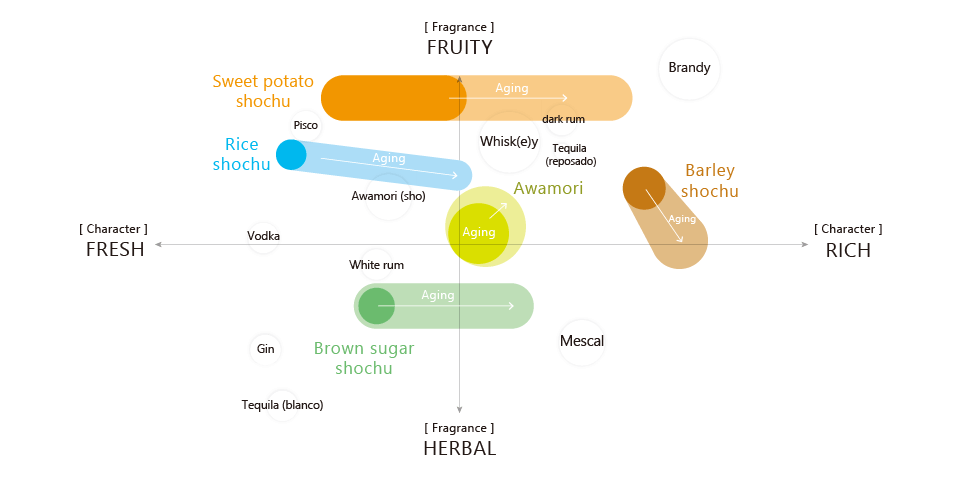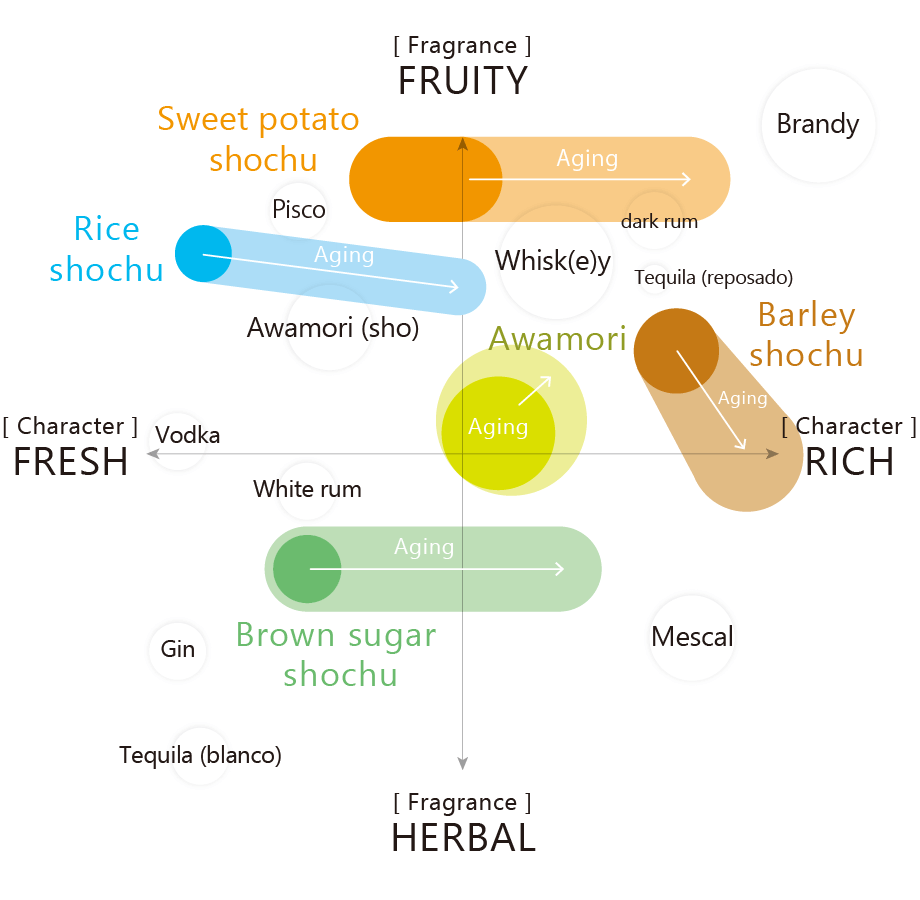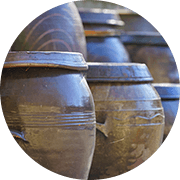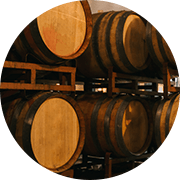Shochu 101

STANDING POSITION IN WORLD SPIRITS
If we compare its aroma and character to other spirits from around the world, we can start to understand where shochu stands.
Where does shochu stand in comparison to the major spirits available around the world, such as whiskey, gin, rum, and tequila? We have tried to illustrate this, including how it changes with aging, in the chart below. Although this is entirely a matter of perception, it should provide a rough idea of its position. We can see that shochu appears all over the chart depending on what raw ingredients it uses. Furthermore, sweet potato shochu ranges from those like Pisco to full-bodied types resembling Jenever, and rice shochu covers everything from fresh, vodka-like styles to those more like whisky. Compared to other spirits, it is difficult to understand shochu as a single entity, so it is vital to accurately grasp the characteristics of each different ingredient.
Where shochu stands among the spirits of the World


Sweet potato shochu
Sweet potato shochu is aromatic and varied in its elements. It has fruit notes such as of lychee and mango, and floral notes of lavender and roses. It becomes richer as it ages.
Barley shochu
It has a richness and flavor that rivals lightly barrel-aged whiskey or rum. As it matures, the nose settles down and its flavor develops to become fuller and more intense.
Rice shochu
It has a light and high fragrance like that of ginjo sake, with hints of green apple, citrus, melon, etc. Rice shochu produced using atmospheric distillation retains the powerful aroma and savory flavor of rice.
Brown sugar shochu
It has a light, crisp, green aroma, similar to unaged rums and cachaça. As it matures, it develops a richer, fuller body, with little change in fragrance.
Awamori
Moderate in both fragrance and character. With age, it develops a richer and fuller flavor and a fruity aroma.
Raw materials of the world's spirits
Honkaku shochu: sweet potatoes, barley, rice, brown sugar, etc.
Awamori: rice (Thai rice)
Whisk(e)y: barley, rye, corn, etc.
Brandy: grapes, apples, pears
Rum: sugarcane (molasses / juice)
Tequila: 100% agave
Mescal: agave
Gin: barley, rye, potatoes, juniper berries, etc.
Vodka: barley, wheat, rye, potatoes, etc.
Pisco: grapes
Keyword 01
FLAVOR

A unique aroma found only in shochu
The alcohol content of most shochu and awamori is between 20 and 30 percent, which is substantially lower than other world spirits, which are mainly over 35 percent. Since its alcohol content is low, its aroma can be easily discerned from the moment it is poured into a wine glass. Also, different flavors can be discerned even with the same ingredients, because despite being a distilled spirit, the differences in the koji and yeast used also have a substantial impact. It produces an aroma unique to shochu, quite unlike that of beer or wine. The flavor of shochu can be described as a multiplication of koji, yeast, and the main ingredient. That structure itself already resembles a cocktail, and it produces an aroma that you would not expect from the ingredients. By understanding these flavors, you can create cocktails that no one has ever tasted before. These are the kinds of unrealized possibilities that shochu holds.
Keyword 02
KOJI

Brewing with koji gives shochu its aroma, flavor, and oiliness, as well as a unique depth of sweetness
Koji, which is made by adding koji mold to steamed rice and letting it reproduce, is essential for Japanese fermented foods such as soy sauce and miso. Similarly, koji plays a major role in shochu and awamori, both of which have been developed in a culture of fermentation. Koji is absolutely vital for producing the flavor, oiliness, and deep sweetness of shochu. Spirits from other places in the world, by contrast, put a lot of emphasis on distillation and aging. Throughout its long history, stills have been the subject of much research, and the associated aging and blending techniques have been explored. Now, the world is beginning to see a reversal. Just as fermentation is drawing attention in the world's culinary industry, the world of spirits is showing growing interest in koji and fermentation: new spirits using koji are being created, and new flavors using previously unknown yeasts are being studied. The knowledge of yeast and koji that the Japanese have been exploring for many years can serve as important information for the global market.
Keyword 03
DISTILLATION

Stainless steel stills give each distillation meaning
While most of the world's stills, such as those for whisky, are made of copper, most shochu stills are made of stainless steel. Direct distillation, in which steam is blown directly into the mash, has become the most common method of distillation. This is because it offers a way to heat mashes of easily-burned ingredients without burning them. Moreover, the alcohol content of shochu is defined as 45 percent or less. There is no limit on the number of distillations, but they are usually distilled only once and finished to 20-25 percent alcohol by volume. For this reason, it is a spirit with many aromatic components, and one that brings out the characteristics of its ingredients well. Shochu is one of the few spirits in the world to be drunk with meals. The culture of mixing shochu with hot water and drinking it with food is deeply rooted. It is a distillation method unique to shochu, which is designed to retain a certain amount of oil—that is, plenty of flavor—and to bring out the flavor of the ingredients when mixed with hot water.
Batch distillation
Batch distillation brings out the flavor of the ingredients well. The alcohol content that can obtained in a single distillation is low, and distillation may be repeated. Differences in the shape of the still can produce a variety of flavors. The stills used for this kind of distillation are known as “pot stills.”
Malt whiskey / tequila / cognac (brandy) / rum / honkaku shochu (potato, barley, rice, brown sugar) / awamori / gin (often combined with continuous distillation) / some rums
Continuous distillation
A relatively new distillation method that started to see use in the 19th century. Mash can be continuously fed into the still, allowing the efficient production of drinks with high alcohol content. This produces clear drinks that retain little flavor from the original ingredients.
Grain whisky, bourbon whisky (pot stills also sometimes used), grape brandy, vodka (pot stills also sometimes used), rum, and korui shochu
Keyword 04
FILTRATION

How oil is left in during filtration determines the weight and character of the shochu A mentality distinct from other spirits around the world
Compared to other spirits from around the world, shochu has a completely different approach to oil. The oil component of shochu brings roundness and depth to the taste. Therefore, as opposed to the world's spirits, which compete for a “clean” flavor in terms of how much filtration is used to refine the taste, the taste of shochu is determined by how it is filtered to retain as much oil as possible. That said, excess oil will oxidize and spoil the taste. Conversely, if too much oil is removed, the shochu will be “clean,” but its depth of flavor will be reduced. For this reason, shochu producers use various methods such as skimming off the oil with a net and filtering it out with paper, depending on the character of shochu they are aiming for.
Keyword 05
ALCOHOL BY VOLUME

Even with an alcohol content of 20 percent, shochu’s strong flavors allow it to be used in cocktails
As can be seen by the growing popularity of non-alcoholic “mocktails,” health consciousness is driving a worldwide demand for cocktails with less alcohol. Some people think that shochu’s low alcohol content makes it unsuitable for cocktails, but if the flavors are strong enough, it can work as a low-alcohol cocktail, which actually has its advantages. For example, by adding 20ml of 25 percent spirits instead of 20ml of 40 percent spirits, you can create a cocktail that has a gentle fragrance and a soft mouthfeel while keeping the alcohol content in check. However, it's hard to make a cocktail if it is weak in terms of both alcohol and flavor. Such shochu is best enjoyed mixed with hot or cold water.
Shochu / Awamori
20~30%
World spirits
35~45%
Keyword 06
AGING

From a global perspective, shochu is more valuable when it can be spoken of like whisky in terms of aging
Maturation for long periods of time holds new possibilities for shochu. Whether aging is done in tanks, pots, or barrels, they all have one thing in common: as the shochu ages, gas and fungal smells are eliminated, and the flavor becomes more mellow. This is particularly true for rice and barley shochu: when the raw spirit is left in a barrel to age, it develops a character comparable to whisky. However, the value of aged shochu has not been well established in Japan. For example, if shochu is stored in oak barrels in the warm climates of Kyushu and Okinawa, it will mature quickly and take on the aroma of the barrel. As such, it is said that the 30-year aging periods used for whisky in Scotland may not be strictly necessary. There are still many things that remain unclear, such as differences in aging methods and how to identify the peak of maturity, but thinking globally, if there is shochu that can be spoken of like whisky in terms of aging, then its value will surely increase.
Types of shochu aging

Tanks
Typically made of enamel. They do not impart any color, and only the character of the shochu matures, unaffected by any external factors.

Pots
Maturation occurs quickly. The distinctive smell of earthenware can produce a natural sweetness, but sometimes the flavor becomes muddy.

Barrels
Extracts from the barrels seep out and transform as they mix with the raw spirit. Different types of barrels work well with different types of shochu.



